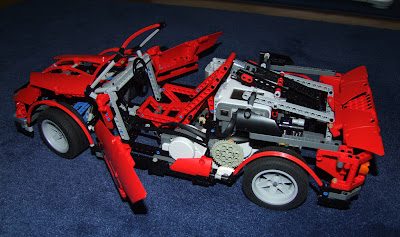
When talking about classic Technic supercars, it's the 8880 which (rightly) usually gets the largest spotlight. However, its predecessor, the 8865 Test Car, was just as advanced and innovative for its time. The one I've built doesn't adhere entirely to the original's colours (some original parts got damaged in those 20+ years), but mechanically it's accurate.
This set was released in 1988 ― of course, deeply in the era of studded beams and brittle toothed connectors. It relies on so many standard parts that it should be fairly simple to build if you've got a good "general" collection of studded Technic, and some special parts such as the front suspension hubs and the old differential can be replaced by their modern equivalents fairly easily. Altogether it's still visibly simpler than the 8880, but curiously, it's a tiny bit longer, wider and higher.
 Besides the part assortment, one noticeable difference to the modern Technic sets are the instructions. At 892 parts and featuring many complex systems, modern instructions for the 8865 would be spread into two or even three booklets, while the original's consist of just one booklet which isn't too thick (and shares space with the B model). The fact, provable also through other Technic sets from the time, is that the building steps were much more condensed back then, introducing many sub-steps and handling several components simultaneously. Often requiring very careful inspection of drawings to notice the changes.
Besides the part assortment, one noticeable difference to the modern Technic sets are the instructions. At 892 parts and featuring many complex systems, modern instructions for the 8865 would be spread into two or even three booklets, while the original's consist of just one booklet which isn't too thick (and shares space with the B model). The fact, provable also through other Technic sets from the time, is that the building steps were much more condensed back then, introducing many sub-steps and handling several components simultaneously. Often requiring very careful inspection of drawings to notice the changes.The features and functionalities the Test Car offers clearly overshadow its own predecessor, the 8860. It has a V4 engine (the first Technic engine with a V layout), built from old large square pistons and using the offset axle holes in the 24T gears to form a crankshaft. It is connected to a linear axle-sliding gearbox with 3 speeds and neutral, which leads to the differential at the back.
Front independent suspension utilizes special parts relying on ball joints to allow steering, and follows the Ackermann geometry. It is based on usual rack & pinion mechanism, linked to the steering wheel in the cabin. The rear double wishbone suspension doesn't use special parts as an "easy way out", but is instead built from standard parts ― mostly beams, pins and plates, with hinge points precisely adjusted with the U-joints' fulcrums. This structure is quite wide, and together with the need to fit the differential on the same axle, it defines the car total width.
 Headlights can be also extended and retracted using a lever in the cabin. The lever rotates a simple crank that raises or lowers the (purely decorative) lights. Finally, almost everything can be adjusted regarding the seats: the back and headrest angle with standard hinges, and the front-back position via rack & pinion.
Headlights can be also extended and retracted using a lever in the cabin. The lever rotates a simple crank that raises or lowers the (purely decorative) lights. Finally, almost everything can be adjusted regarding the seats: the back and headrest angle with standard hinges, and the front-back position via rack & pinion. The bodywork composed mainly of 16L and 12L beams is quite basic, especially in comparison to the modern-age Technic models, but it gives a fairly good idea of the overall outline of the car. It's rather sturdy and, together with a strong chassis, makes the 8865 one seriously shockproof model.
Along the lines of the deep-studded era Technic, there's no real static decoration here. As mentioned, even the headlights are moveable, and the engine fan rotates together with the crankshaft.
However, the model isn't entirely flawless. Changing gears is difficult, and usually impossible if the car is static (it was the later 8880 which introduced a smooth synchronized gearbox with dog-rings). The friction of the parts causes quite a strain on the parts in the first gear if extreme caution was not given to allowing slack in the transmission and suspension, or if the engine crankshaft it offset by the tiniest amount.
But altogether, 8865 is undoubtedly among the all-time Technic flagships. It is also a good demo of how much is possible using mostly regular Technic parts and a few well-known mechanisms.
GALLERY







GENESIS (Timelapse)













































